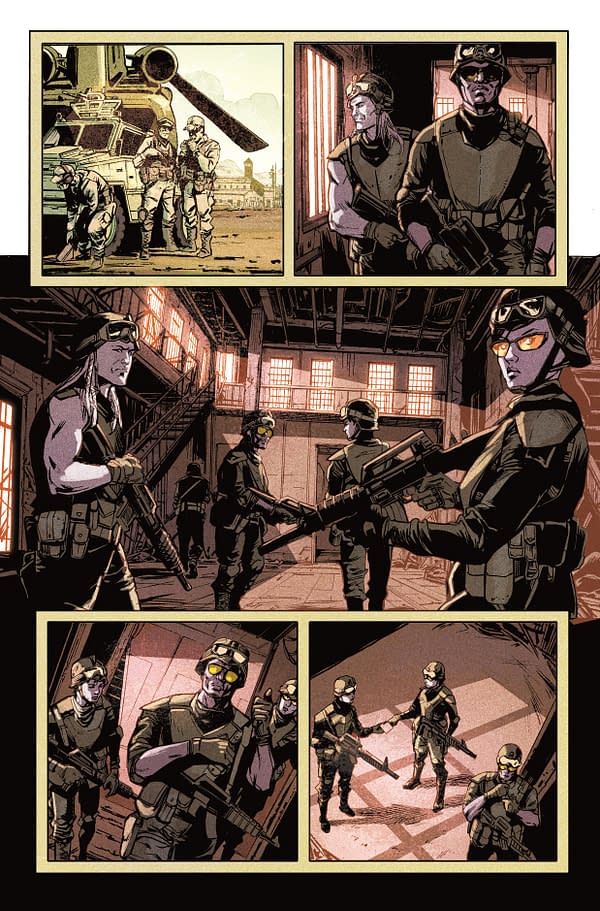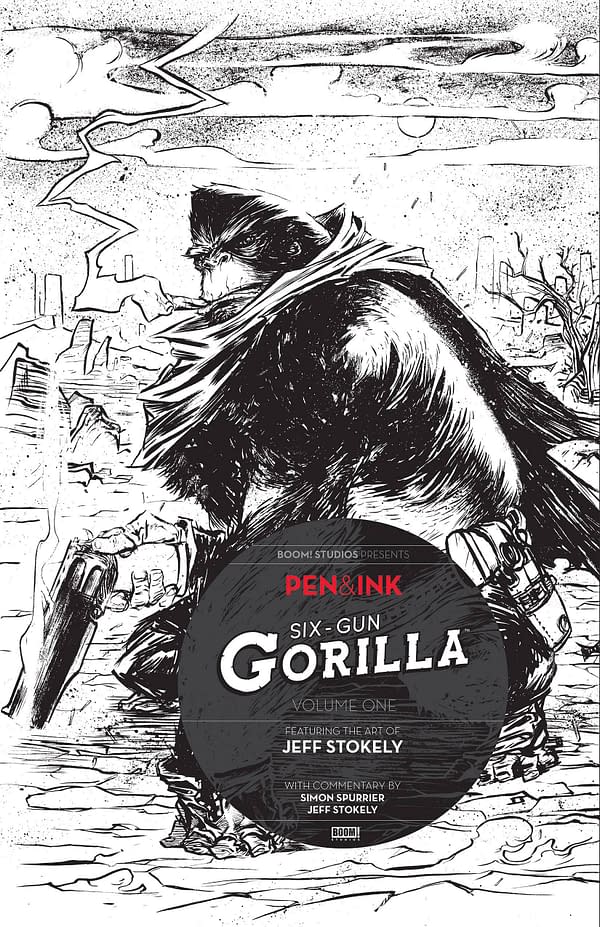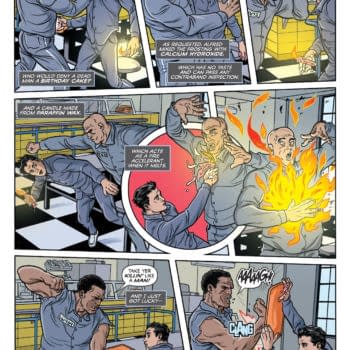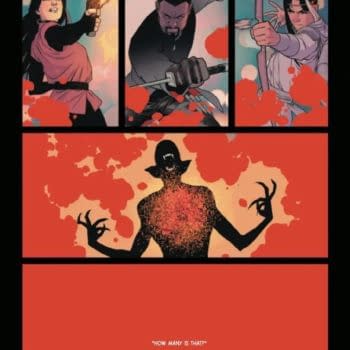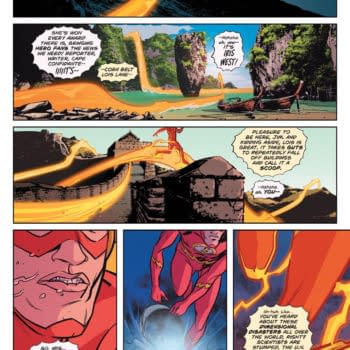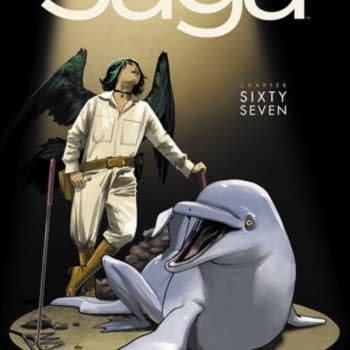Posted in: Comics | Tagged: cry havoc, image comics, Jeff Stokely, simon spurrier, six gun gorilla, The Spire
Folklore Is 'Older And Stranger' In Cry Havoc – Si Spurrier In The Bleeding Cool Interview
Cry Havoc, the new Image series from Simon "Si" Spurrier and Ryan Kelly was announced this week to much fanfare, including the endorsement of Alan Moore, from whom Spurrier continued the series Crossed +100. One of the series log lines, according to its newly launched Tumblr, is "Fear + Folklore + Firepower".
Having spoken with Spurrier at length about this new series at New York Comic Con, I am particularly impressed by the accuracy and nuance behind that description. This is a series that digs deep into the public subconscious, delving far into the past and confronting the past with the present. As is suggested the solicit info and covers, this is a comic series which will feature a central character who appears to be some form of werewolf, and she, along with others who may be "afflicted" in a similar folkloric way, are going to find themselves facing a war zone in Afghanistan.
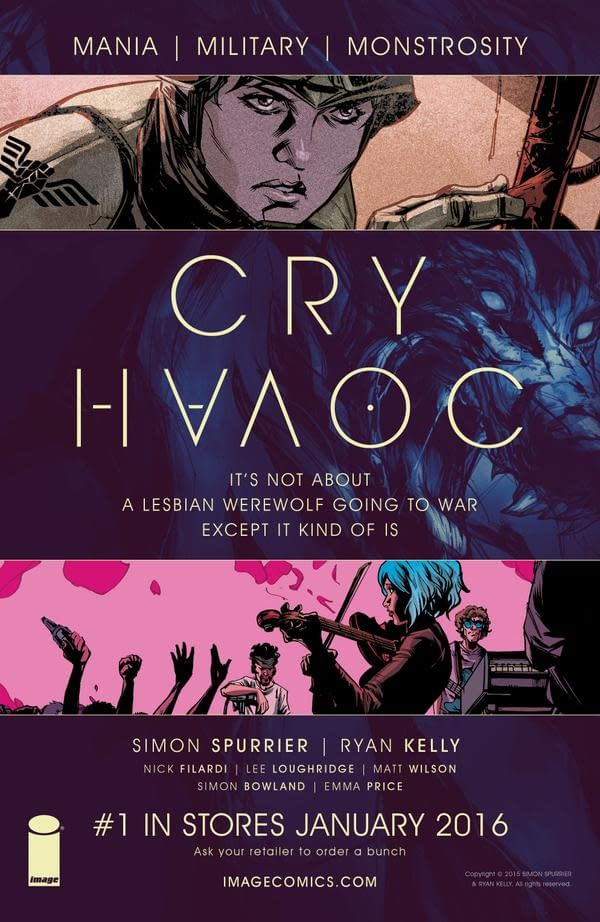
Talking to Spurrier about Cry Havoc (a title taken from Shakespeare's Julius Caesar: 'Cry 'Havoc' and let slip the dogs of war!') has only infected me further with the suspicion that this might be one of the most poignantly punchy and significant books of 2016. This is the first book to make me feel like 2016 is going to be a strong year for comics.
Now, Spurrier and I are incapable of staying totally on topic, so come along and follow our discussion of social media, editing, indie comics, working on creative teams, and the deep, dark significance of the vestigial remains of folklore in our modern lives.
When I described Cry Havoc as a "weird horror book", Spurrier said:
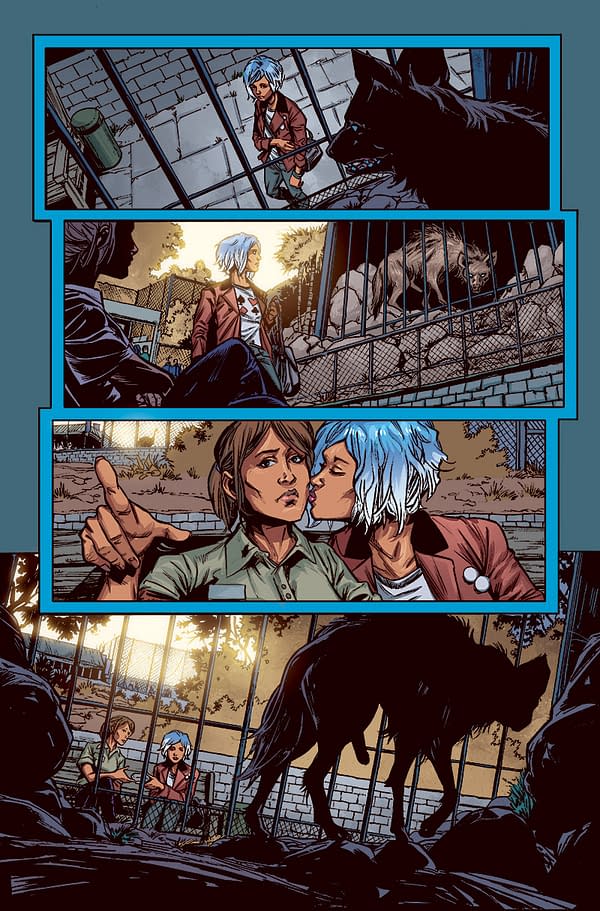
HMS: [Laughs] It is typical of you, because even when writing Crossed, it was always about something else, and there was so much going on in that comic. But that's not a bad thing at all.
SS: It's fine. I just wait for somebody else to tell me what it is about. Regarding The Spire, somebody said, "Oh, it's Dark Crystal meets Bladerunner". Yes. Cool. That's what that book is.
HMS: The Spire is a beautiful book.
SS: Jeff [Stokely] is amazing. I've worked with many close friends, but not with the degree of closeness that I have with Jeff. To the extent that I, despite being a hideous control freak, have started leaving stuff out of my scripts, since I know that Jeff will make things up and it will be great, and I can write around it. That's what comics are about. I have this chat with Kieron [Gillen] often, since I am often jealous of his relationship with Jamie [McKelvie]. If they hadn't found each other, their careers would have gone in different directions.
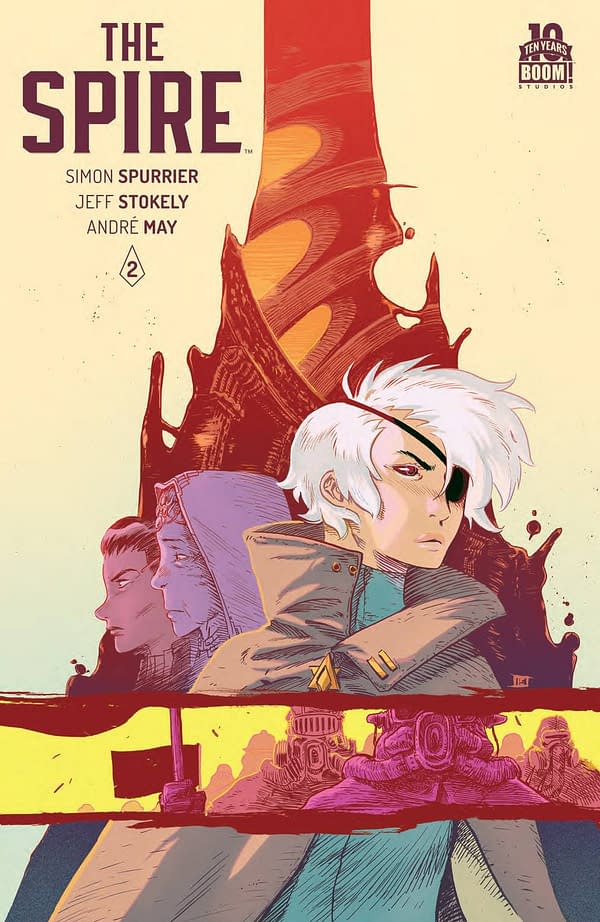
SS: Yes. It's an exercise in human dynamics, human engineering. That's something I didn't expect working on this Image book, was the degree to which I became project manager.
HMS: Oh, you just touched on a big discussion that's been going on lately! You answered my question.
SS: Which is what?
HMS: Which is: are we in an Image world now where editors are no longer necessary? The conclusion I reached was that there still has to be someone who is the project manager on a creator-owned project.
SS: I think having a manager is something that happens, whether intentionally or not, organically. Whether that's the same thing as having an editor in the editing sense, I don't know.
HMS: Someone has to be on the production schedule, and on deadlines.
SS: Yes, keeping everything on time. We've made this rod for our own backs on Cry Havoc in having three colorists, so three times as many e-mails.
HMS: Yes! The cover has so many credits, and I recognized at least two as being colorists right away.
SS: The way the story is told, there are different time periods, but being featured in parallel, and each has a different colorist. The idea being that colorists don't really get much of the glory in comics, short shrift. We thought it would be a nice way of differentiating between these threads, keeping the story instinctively understandable, and also showing how much of a difference a colorist can make. One artist, three colorists, and they look like three differently drawn pieces.
HMS: You may be the first people who have intentionally done that on a project.
SS: I think we are.
HMS: There have been a couple of books in the past few years who used different color schemes for different time periods or settings, like E8ht by Rafael Albuquerque, but I haven't heard of having different colorists doing those segments. That's new.
SS: As far as I know, we're the first to do it. It felt like the right time to do it. This emerged out of a lot of conversations about colorists getting the credits they deserve. We thought, well our book has three threads , wouldn't this work there? Also, in the most crass way possible, we have three more names that people might recognize, and three more people on Twitter sharing the work. You can't overestimate the importance of that these days with Image books, to have partisan creators saying nice things about the work.
HMS: I was having this discussion recently, about how important it is to have every member of the team on just about any book, reaching out through their social networks to promote. Even if you're saying "Sorry for sharing this link yet again", just do it anyway. Because that's how a book survives and that how you keep it going. The bigger the team, the more reach you may have.
SS: I am forever feeling guilty when tweeting about my own work. It makes me feel like I'm being really uncool.
But I was talking with Leigh Alexander recently, she's a games journalist and intersectional feminist and all-round great person, and I mentioned this stuff to her. And she said, 'That's ridiculous. Those people choose to follow you because they like your work. The least they can do is pay attention when you tell them something new is available. If people get fed up with it, they weren't going to support your brand anyway'.
HMS: Or they won't follow you anymore, or whatever. Same difference. I think that we often don't even know what a fine margin there is on a book surviving. I think that if one annoying Tweet a day makes sure that your project follows through and you don't live with regret about leaving something unfinished, isn't that worth it?
SS: I think it is. I haven't yet determined how influential Twitter is in practical terms. But then, I saw some numbers once that said, 20% of people online have a Twitter account, and that seems amazing, and then you realize, 80% don't. My law that I keep harping on about is, 'Factions speak louder than herds'. If someone is in a small group, they will shout louder than big groups. This is true of every single aspect of online interaction.
If someone speaks up and says, 'Hey, this book's amazing'. Can you trust that it's representative?
If someone says they are offended by a book, can you be sure they're anything more than an outlier? It's really hard to treat Twitter as anything more than interesting, rather than basing your decisions around perceived reactions, movements, or trends on social media.

SS: I think what it comes down to is the question: to what extent do facts matter? This will sound very wanky, but as a story creator, something means more to me if it's satisfying than if it's true. People say Wikipedia is rubbish because you can change the information, there's no authority, but inasmuch as I'm using it to gain information for stories and essentially talking to people, it doesn't matter if it's entirely accurate or not. It's doing what it's supposed to do. I know that's the thin end of a very stupid wedge, and if you go too far down that path facts don't matter.
But… y'know… maybe they don't.
HMS: Well, there's something to be said for judging a thing by its own qualities. As long as you know what it is that you're looking at, possibly everything is useful, if you just know that usefulness is.
SS: Yes. Especially in the context of stories, something is at its most efficient if it's being responded to. Not when it's being "true".I have these brilliant discussions with my wife, because if I'm telling a story to a group of friends I will inevitably exaggerate. And she hates that , saying, "That's not exactly what happened. It wasn't five frogs, it was only three frogs". But I'm thinking, "But it makes it a better story". And it's true enough. It's a more enjoyable story as a result.
Stories is what Six-Gun Gorilla was about. Stories is what X-Men: Legacy was about. Stories is very much what Cry Havoc is about. It's about living stories. That's what folklore is, ultimately: stories that got big enough that people started to treat them as if they were real.
HMS: Folklore is living story in the sense that it can keep changing as well, and hasn't ossified into just one possible version, too, right?
SS: That's one of the themes of the story, Cry Havoc. It's the reemergence of things that are no longer relevant, but are still wonderful and beautiful. We tend to sneer at old explanations for, say, why your hair gets tangled at night, like there's a goblin running around tying knots in your hair. Of course there's not, but that's a better explanation than the real one, and that's true of all these folkloric things. One of the questions at the heart of Cry Havoc is: What happens when you are the story? When you are something that is possibly no longer relevant, can you make yourself relevant?
Which is why this poor girl, whose life is chaotic…
HMS: This is Louise?
SS: Yes…gets turned around by this strange occultish attack, and ends up going to Afghanistan. In a thematic sense it's a way of plugging in something that's totally not modern with something that is bleedingly relevant today.
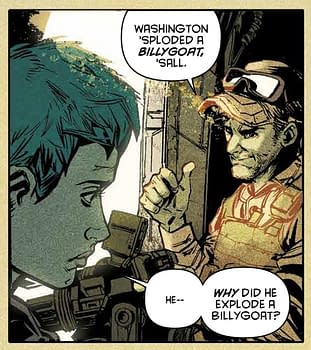
SS: Well… look, I'm not in any way religious, in fact almost the opposite, but to risk descending into slightly pretentious storytelling territory again, we are unique creatures who have the ability to make stuff up and respond to it as if it's real. That's extraordinary. We are peddlers of lies. And people know that they are lies, but they respond to it as if it's real.
HMS: And that seems to go pretty far back in our evolution, too.
SS: It's clearly the root of all spirituality, the root of all religions. To me, the religions are wrong, but that doesn't mean they aren't causing people to respond emotionally to things. That's what's really interesting, is how people respond.
HMS: I saw an article online talking about how the chemical reaction of fear is measurably the same for a real experience as to encountering a horror film or story.
SS: Yes. You watch a soppy movie and it makes you cry. It makes no sense, but you do. You watch a horror film and jump out of your seat. You're in no danger, but you feel as if you are.
HMS: The brain records it in the same way, as the same level of experience, chemically.
SS: That's beautiful. It goes back to what we were saying before. Does truth really matter? Evidently not. The truth is what we make of it. And two people can experience the same truth in two completely different ways anyway, so why shouldn't we massage the truth and decide what we want it to be, rather than letting our brains decide for us?
HMS: Well, whether we acknowledge it or not, we are being influenced in that way too. All those things that have fed into our intellect over time are being interpreted by our brains in different ways.

HMS: The direction you all have chosen to take on this story is interesting to me, since you could take these same elements and turn this into a science fiction story, but instead you're looking backward to the past, back to the cave paintings instead. To reevaluate the past or contrast it with the present.
SS: I think it makes more sense to do that simply because if it were something more futuristic, it would be about creating new mythologies. Whereas I'm saying, "We've got all these wonderful old myths which are obsolete. What happens when they want to be relevant again?" New mythologies arise as a result. In fact, there's a whole plot point which revolves around the "one true myth", the "zeitgeist", the "time-ghost". It becomes the lynchpin of these three stories.
It's really, really fiddly telling three stories alongside each other so that they complement each other, so that the surprises in the first thread are delivered in such a way so that they don't seem disingenuous in comparison to the things that have happened in the second or third thread.
HMS: Is there any particular reason you chose the three story structure?
SS: For that very reason. Because it means that you can deliver information in fascinating way. For me, comics is pacing. My job, as a writer of comics, is to have the skill to disseminate information in a rhythmic way. That's what writing comics is. So, it felt fun to be able to tell three portions of the same character's story in parallel, so beats end up having unexpected relationships with each other. Now, if you're reading the middle section, your protagonist already knows what has happened in the first section, so you have to be careful not to alienate the readers from her. Because they could argue that she's not giving them all the information that she has at her disposal. It has to be sympathetically done. You have to find ways to deliver the peaks and the troughs in all three threads in a way that they complement each other.
I think it's working. We underestimate the sophistication of the reader's brain, I think. Readers are very good at just going, "Well, this is challenging. it's not a simple, linear story, but it works".

So, why the music, though? And why this image? It seems very important.
SS: It's funny, one of the log lines we were originally going to use was going to read, 'Music, Myth, Monsters'. But actually the book isn't really about music in the way that a comic like Phonogram is about music. I suppose, for me, Lou's talent is a shorthand for demonstrating she's a woman who possesses creativity. She's not necessarily defined by logic, but by passion, excitement, and all the rest of it.
HMS: She already knows that she moves in a world she does not fully understand.
SS: I'm a big believer in the controlling idea when you write a comic. Especially when you write something as fiddly as Cry Havoc.
HMS: You need that strong central image.
SS: And I can't tell you what the controlling idea is, since it'll give everything away, but it's at the core of this whole thing. This tension between control and chaos, basically. That's what it comes down to. And Lou, as a character, has been conditioned to believe you should be in control, but is almost continually guided by chaos. So the nature of the story is whether she overcomes the chaos or discovers that maybe control isn't so great, either. I'm coming very close to giving away too much!
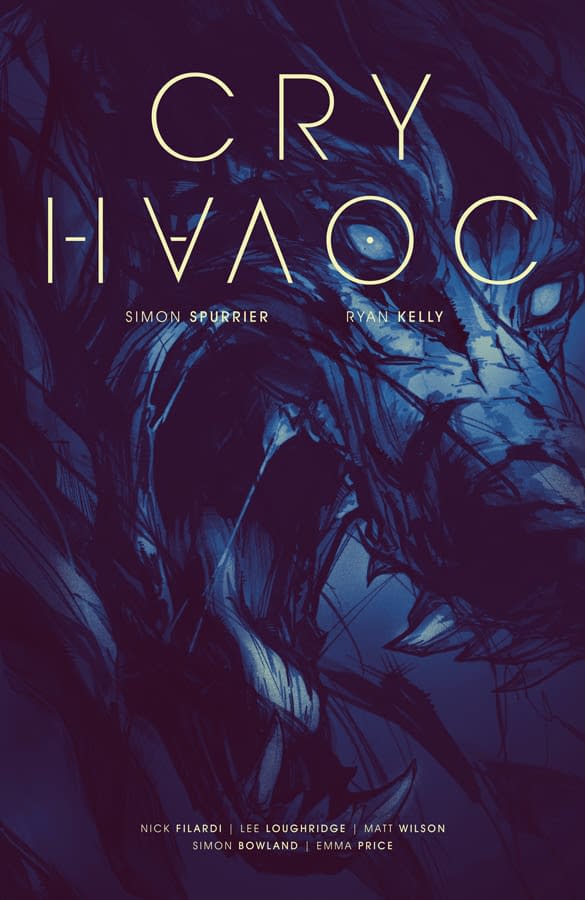
Now, this first issue has an essay in the back written by you that gives a little insight into this book as well. It made me feel like this is your book about Monsters, with a capital "M". You do tend to do "studies" of certain ideas in your comics, like Numbercruncher was a study in metaphysics and math.
SS: Yes, they do tend to be explorations of particular things. That's a fair thing to say. It's probably true of everything I've written, but less for some than others. This one, yes. It was Fiona Staples who said something really nice. She's doing a second issue variant cover. Cameron Stewart did one for the first issue. The reason I mention her is because when I sent her the first episode, she said it made her think of the old 1990's Marvel and DC "monsters going to war" books like Howling Commandos. But a very "Image" take on that idea. And that's exactly what I've found myself doing. Monsters going to war.
HMS: That immediately reminds me of old mythology like Ragnarok, too. Very ancient ideas about monsters fighting each other and destroying the world.
SS: Yes. The idea is that there's this special team going out to Afghanistan, each of whom is monstrous in some way, and each episode focuses more on one of them than the others. Hence each of the main covers is going to showcase another of the different creatures. It's funny you mention Ragnarok, because the creature put into the spotlight for issue two is tied into Norse mythology.
HMS: Can you tell us more about the art on the book?
SS: Ryan Kelly is amazing. I thought he'd be too busy to say yes, frankly. He had just come off Three with Kieron Gillen, and Kieron put us in touch. His Northlanders run is one of the highlights of that series and his career. He's just very, very good at telling stories. He's not a guy who's more interested in style than in story. He just depicts it in the most clear and wonderfully composed way possible. He's also really, really good at designing monsters.
HMS: There seems to be a copacetic thread between his past projects and this one. Is it by association or by his inclination?
SS: You'd have to ask him! I didn't consciously pick him because he's a monster guy or a military or whatever. I just really liked his work. But he also does understatement really well. What I was saying before about 'Lesbian werewolf who goes to war'? We've leaned into that little motto because it's true-ish and it's punchy as hell, but, hopefully in the same way that people realized there was more going on than you'd think at first appearances in Six-Gun Gorilla, so Cry Havoc isn't really about that at all. To help us out, we didn't want it to be a werewolf running around looking like every other werewolf in stories. Because it's not: it's a Shuck or a Barguest… something far older and stranger.
HMS: It's going to take you back further than typical modern Western assumptions about werewolves.
SS: Yep. So, Kelly has created this thing. We don't see it much in the first episode, but it's this rangy, lank, graceful dog-thing. And it occurred to me that the biggest thing he'd done, that seemed so minor but works so perfectly, was to give it dangling ears rather than sticking up ears. It made it unlike any other werewolf people had seen.
HMS: That suggests other cultural context, too.
SS: The second issue touches on this a lot, but I was already really interested in the Black Dog myths we have in Britain. We in the UK tend to depict Black Dog myths as Dobermans, or Mastiffs, or Hounds but the same sorts of myths in mainland Europe tend to be depicted as a Poodle. A giant black Poodle. Whereas we think of Poodles as silly toy dogs. Shaggy dog stories, literally.
HMS: There are so many associations between black dogs and the gateway to the Underworld.
SS: And also with depression. Because the euphemism du jour for being depressed is saying you're 'having a black dog day'. As with X-Men Legacy, there's a lot of allegory in Cry Havoc about inner demons, mental health, emotional well-being. Lou even makes a grim joke about it, at one point, because she's struggling with what's happened to her, and she calls a Samaritans-type helpline. And they ask her if she's having a 'black dog day', while she's sitting there, covered in fur and blood.

SS: Stories about stories. There are no limits to these. Folklore being what it is, each country has its own continuum. I hate this idea of canon, which fixes the idea of a god being a god or a spirit being a spirit, whereas in fact they are syncretized with each other, and blurred over time.
HMS: It's amazing how much difference the language makes, too, in the interpretation of different words. We argue so much for similarities when we compare folktales, but we need to allow for the differences too, that are fascinating.
SS: I think it's a mistake to taxonomize. It's more delightful to me to think of some kind of proto-dog idea. We're sitting at the campfire. What do we imagine outside the light? Something big and black and shaggy. It's written into our cultural DNA in Europe, and I imagine it's written elsewhere in the world, too. That's the cool thing about having an international team in this book, going to Afghanistan, is you get to explore folklore from all over the world.
CRY HAVOC #1 Cover A by Ryan Kelly and Emma Price (Diamond Code NOV150482) will hit comic book stores on Wednesday, January 27th. Cover B by Eisner Award-winning artist Cameron Stewart will be available with Diamond Code NOV150483. The final order cutoff deadline for comic book retailers is Monday, January 4th.


